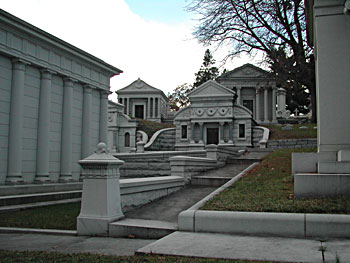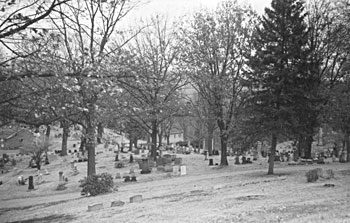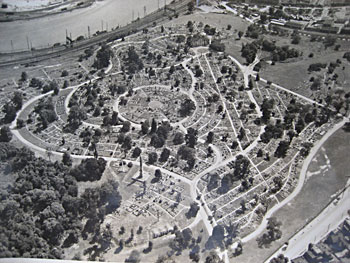1833-1875: Rural Cemetery Movement
In the 1830s three major cities in the United States - Boston, Philadelphia, and New York - established large rural cemeteries on sites carefully chosen for accessibility and natural beauty. Mt. Auburn (1833) in Boston, Laurel Hill (1836) in Philadelphia, and Green-wood (1838) in Brooklyn, established park-like, picturesque cemetery patterns that quickly influenced other American cities as Victorian concepts of death flourished. These cemeteries were privately owned and operated and offered peaceful, romantic resting places for both the wealthy and the average citizen. Family plots were the norm. Prominent citizens often hired the finest architects to design large, elaborate mausoleums, obelisks, or beautifully sculpted monuments for their own areas. Plots could be defined by carved granite stonework, sculpted rails and gates, or iron fencing. The elaborate sculptures achieved by the stone craftsmen of the day are unparalleled in any subsequent cemeteries.
In Pennsylvania, Laurel Hill Cemetery was built along the east bank of the Schuylkill River. In 1840, Woodlands Cemetery Company used the former William Hamilton estate to lay out the Woodlands Cemetery in West Philadelphia. In Pittsburgh, Allegheny Cemetery.
The preservation of Rural Cemeteries is a daunting task due to the lack of endowed plots, the variety of materials involved in funereal monuments, landscaping responsibilities, and the overall size of the resources.
Monuments are usually of marble, granite, local stone types, and sometimes zinc. Highly sculpted, three dimensional styles and mausoleums prevail, though more traditional monuments types were also installed.
Two important precedents influenced the Rural Cemetery movement: New Haven's New Burying Ground (1796) and the Pere Lechaise Cemetery (1804) in Paris. Both promoted the idea of a non-sectarian burial space free from church and municipal oversight in a park-like setting. Pere Lachaise in Paris introduced a deliberately designed landscape for mourning through the incorporation of English romantic landscapes of varied topography, picturesque curving drives, separated pathways, classical monuments, and a series of carefully constructed scenes that removed the urban dweller from the noise and congestion of the city. The pastoral environment allowed for both a period of reflection on the dead and a place of relaxation and enrichment for the living.
 |
| Laurel Hill, Philadelphia |
 |
| Other Later Cemeteries |
 |
| The Woodlands, Philadelphia |